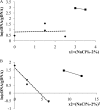Metabolic shift of Escherichia coli under salt stress in the presence of glycine betaine
- PMID: 24858086
- PMCID: PMC4148810
- DOI: 10.1128/AEM.00599-14
Metabolic shift of Escherichia coli under salt stress in the presence of glycine betaine
Abstract
An important area of food safety focuses on bacterial survival and growth in unfavorable environments. In order to understand how bacteria adapt to stresses other than nutrient limitation in batch cultures, we need to develop mechanistic models of intracellular regulation and metabolism under stress. We studied the growth of Escherichia coli in minimal medium with added salt and different osmoprotectants. To characterize the metabolic efficiency with a robust parameter, we identified the optical density (OD) values at the inflection points of measured "OD versus time" growth curves and described them as a function of glucose concentration. We found that the metabolic efficiency parameter did not necessarily follow the trend of decreasing specific growth rate as the salt concentration increased. In the absence of osmoprotectant, or in the presence of proline, the metabolic efficiency decreased with increasing NaCl concentration. However, in the presence of choline or glycine betaine, it increased between 2 and 4.5% NaCl before declining at 5% NaCl and above. Microarray analysis of the transcriptional network and proteomics analysis with glycine betaine in the medium indicated that between 4.5 and 5% NaCl, the metabolism switched from aerobic to fermentative pathways and that the response to osmotic stress is similar to that for oxidative stress. We conclude that, although the growth rate appeared to decrease smoothly with increasing NaCl, the metabolic strategy of cells changed abruptly at a threshold concentration of NaCl.
Figures






Similar articles
-
Growth of Escherichia coli in human urine: role of salt tolerance and accumulation of glycine betaine.J Infect Dis. 1992 Dec;166(6):1311-5. doi: 10.1093/infdis/166.6.1311. J Infect Dis. 1992. PMID: 1431248
-
Glycine betaine, carnitine, and choline enhance salinity tolerance and prevent the accumulation of sodium to a level inhibiting growth of Tetragenococcus halophila.Appl Environ Microbiol. 2000 Feb;66(2):509-17. doi: 10.1128/AEM.66.2.509-517.2000. Appl Environ Microbiol. 2000. PMID: 10653711 Free PMC article.
-
Glycine betaine transport in Escherichia coli: osmotic modulation.J Bacteriol. 1985 Jan;161(1):393-401. doi: 10.1128/jb.161.1.393-401.1985. J Bacteriol. 1985. PMID: 3881395 Free PMC article.
-
Effect of NaCl-induced osmotic stress on intracellular concentrations of glycine betaine and potassium in Escherichia coli, Enterococcus faecalis, and staphylococci.J Lab Clin Med. 1991 Sep;118(3):217-24. J Lab Clin Med. 1991. PMID: 1919294
-
Adaptation of Escherichia coli to high osmolarity environments: osmoregulation of the high-affinity glycine betaine transport system proU.FEMS Microbiol Rev. 1994 May;14(1):3-20. doi: 10.1111/j.1574-6976.1994.tb00067.x. FEMS Microbiol Rev. 1994. PMID: 8011357 Review.
Cited by
-
Shift of Choline/Betaine Pathway in Recombinant Pseudomonas for Cobalamin Biosynthesis and Abiotic Stress Protection.Int J Mol Sci. 2022 Nov 11;23(22):13934. doi: 10.3390/ijms232213934. Int J Mol Sci. 2022. PMID: 36430408 Free PMC article.
-
Exposure of Salmonella enterica Serovar Typhimurium to Three Humectants Used in the Food Industry Induces Different Osmoadaptation Systems.Appl Environ Microbiol. 2015 Oct;81(19):6800-11. doi: 10.1128/AEM.01379-15. Epub 2015 Jul 24. Appl Environ Microbiol. 2015. PMID: 26209672 Free PMC article.
-
About the dark corners in the gene function space of Escherichia coli remaining without illumination by scientific literature.Biol Direct. 2023 Feb 28;18(1):7. doi: 10.1186/s13062-023-00362-0. Biol Direct. 2023. PMID: 36855185 Free PMC article.
-
Improving L-threonine production in Escherichia coli by elimination of transporters ProP and ProVWX.Microb Cell Fact. 2021 Mar 2;20(1):58. doi: 10.1186/s12934-021-01546-x. Microb Cell Fact. 2021. PMID: 33653345 Free PMC article.
-
Applications of genome-scale metabolic models to investigate microbial metabolic adaptations in response to genetic or environmental perturbations.Brief Bioinform. 2023 Nov 22;25(1):bbad439. doi: 10.1093/bib/bbad439. Brief Bioinform. 2023. PMID: 38048080 Free PMC article. Review.
References
-
- Feist AM, Henry CS, Reed JL, Krummenacker M, Joyce AR, Karp PD, Broadbelt LJ, Hatzimanikatis V, Palsson BO. 2007. A genome-scale metabolic reconstruction for Escherichia coli K-12 MG1655 that accounts for 1260 ORFs and thermodynamic information. Mol. Syst. Biol. 3:121. 10.1038/msb4100155 - DOI - PMC - PubMed
Publication types
MeSH terms
Substances
Associated data
- Actions
Grants and funding
LinkOut - more resources
Full Text Sources
Other Literature Sources
Molecular Biology Databases

